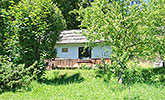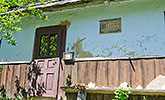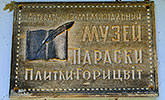Ukraine
Ivano-Frankivsk region
Verkhovyna district
Kryvorivnya
Museums
The Museum of Paraska Plytka-Horytsvit
Description:
Paraska Plytka-Horytsvit was a Hutsul female writer, artist, folklorist, ethnographer, painter and photographer. The museum dedicated to the artist is located in the house where she used to live and work.
Her life journey wasn't the easy one. She ended only four classes in school, but learned German at home being taught by her farther, who could speak several languages. That gave her the opportunity to work as an interpreter during the WWII.
In 1943 she, on her own, got to Germany to enter the university. But instead of studies, she happened to work for a German family where she suffered from emotional abuse. When she got back to Kryvorivnya, she joined the liberation movement and became a messenger of UPA (the Ukrainian Insurgent Army) under the code name Lastivka (the Swallow) bringing to the woods food and warm clothing for the insurgents.
It was the activity that resultet in her expulsion to Siberia, together with thousands of other women from Western Ukraine (1945).
On the way there, she got her feet frostbitten and was put in Ural prison hospital. She was saved from the amputation by a Georgian doctor who she had been gratefully remembering throughout her entire life. Still, the writer could only walk with crutches for almost five years afterwards. In 1947 she served a prison sentence in a prison camp in Spask (Kazakhstan).
In the camp she met a young Georgian artist with whom she fell in love and had been in correspondence for a long time (Paraska managed to send his address home to Ukraine).
After 10 years of camps, Paraska, aged 27, was released under the amnesty of minors and got back home to Kryvorivnya. At her parents' house she found out that the father, being unhappy with her relationships with a Georgian artist, destroyed his letters. The writer couldn't forgive her farther and started living separately in a small room that used to be the farther's forge. She remembered her love for the whole life and dedicated herself fully to her arts. Firstly, she actively participated in public life, took part in tolokas (local communal works), worked as a painter in a forestry enterprise (lisgosp), founded a choir, gathered folklore and did the writing work, painted and photographed. But later, time after time, she started living more and more sheltered life for fulfilling the promise given in prison times — to praise the Lord.
Since than she had been practising the ascetic way of life, living from what the villagers brought her.
In the 1970s she conducted tours around the Carpathians for students.
During her long writing career, Paraska Plytka-Horytsvit had tried out working in lots of genres.
She wrote about 50 handwritten books (about 500 pages each one). After Mykola Dzhura (the director of Ivan Franko museum) granted her a typewriter, Paraska used it for her works. On the whole, she also wrote about 800 smaller books (typed and handwritten) designing bindings, decorating and colouring each one individually. These artworks became the main part of the museum collection.
Paraska was fascinated by the liberation movement of Indian nation and philosophy of peace by the Indian prophet Mahatma Gandhi. Once it was believed mistakenly that she wrote letters to his daughter Indira. The truth is that Indira Ghandi wasn't related to the famous prophet, but still, became a remarkable politician and the Prime Minister of India.
Not surprisingly, Paraska's artistic legacy contains some works inspired by Indian culture and illustrated with her pictures.
She wrote both prose and poetry, including free verse (open form of poetry), fairy tales and even a fantastic adventure novel 'Indian Flames' telling a story about adventuries of Hutsul people in India. She also left her memoirs.
Her artistis heritage consists of paintings and icons, which she often gave as presents to the villagers; several of her icons are still kept in the local church. Besides that, the artist created vytynankas (local art form of papercutting).
Paraska also could sing well and played different musical instruments, which she made herself; together with that, she self-mastered the art of photography.
She took pictures of surrounding nature, religious ceremonies, everyday scenes and portraits of the villagers. Enthusiasts from Kyiv managed to find over 4 thousand photos in 2011. Some of those items were found hidden under Paraska's bed with a written comment 'Failed shots, too pale'. Now those are being admired in different parts of the world. Some of shots are now being restored. Paraska's photos were gathered to form the exhibition 'The Portraits of Time and Place', which is now being actively demonstrated and has been already shown in several cities around Ukraine and Poland. Regrettably, the last years of the artist's life were spent in poverty and infirmity, she got almost bilnd. Nevertheless, that time she was believed to be often visited by local children which brought her a lot of joy. The children recognized her as a good scout, and she often gave them her papercutting and paintings, she also enjoyed very much listening to them reading poems, taking often their pictures.
The interesting fact is that the second part of her surname (Horytsvit) was a pseudonym. Here's a story about that:
'I was very young, that time Paraska was telling us that she added the part Horytsvit, because her fate is like this flower (horytsvit is adonis in Ukrainian). Like this flower, she bloomed brightly but faded fast. I guess it was all about her very private feeling she didn't want to share with anyone only promising me to tell everything when I grow up. But when I did, it wasn't the time for me being busy with my own teenage troubles and hopes. Now, remembering those days, I deeply regret not listening attentively enough to her stories', says Valentyna Kharuk (current head of the museum).
Her life journey wasn't the easy one. She ended only four classes in school, but learned German at home being taught by her farther, who could speak several languages. That gave her the opportunity to work as an interpreter during the WWII.
In 1943 she, on her own, got to Germany to enter the university. But instead of studies, she happened to work for a German family where she suffered from emotional abuse. When she got back to Kryvorivnya, she joined the liberation movement and became a messenger of UPA (the Ukrainian Insurgent Army) under the code name Lastivka (the Swallow) bringing to the woods food and warm clothing for the insurgents.
It was the activity that resultet in her expulsion to Siberia, together with thousands of other women from Western Ukraine (1945).
On the way there, she got her feet frostbitten and was put in Ural prison hospital. She was saved from the amputation by a Georgian doctor who she had been gratefully remembering throughout her entire life. Still, the writer could only walk with crutches for almost five years afterwards. In 1947 she served a prison sentence in a prison camp in Spask (Kazakhstan).
In the camp she met a young Georgian artist with whom she fell in love and had been in correspondence for a long time (Paraska managed to send his address home to Ukraine).
After 10 years of camps, Paraska, aged 27, was released under the amnesty of minors and got back home to Kryvorivnya. At her parents' house she found out that the father, being unhappy with her relationships with a Georgian artist, destroyed his letters. The writer couldn't forgive her farther and started living separately in a small room that used to be the farther's forge. She remembered her love for the whole life and dedicated herself fully to her arts. Firstly, she actively participated in public life, took part in tolokas (local communal works), worked as a painter in a forestry enterprise (lisgosp), founded a choir, gathered folklore and did the writing work, painted and photographed. But later, time after time, she started living more and more sheltered life for fulfilling the promise given in prison times — to praise the Lord.
Since than she had been practising the ascetic way of life, living from what the villagers brought her.
In the 1970s she conducted tours around the Carpathians for students.
During her long writing career, Paraska Plytka-Horytsvit had tried out working in lots of genres.
She wrote about 50 handwritten books (about 500 pages each one). After Mykola Dzhura (the director of Ivan Franko museum) granted her a typewriter, Paraska used it for her works. On the whole, she also wrote about 800 smaller books (typed and handwritten) designing bindings, decorating and colouring each one individually. These artworks became the main part of the museum collection.
Paraska was fascinated by the liberation movement of Indian nation and philosophy of peace by the Indian prophet Mahatma Gandhi. Once it was believed mistakenly that she wrote letters to his daughter Indira. The truth is that Indira Ghandi wasn't related to the famous prophet, but still, became a remarkable politician and the Prime Minister of India.
Not surprisingly, Paraska's artistic legacy contains some works inspired by Indian culture and illustrated with her pictures.
She wrote both prose and poetry, including free verse (open form of poetry), fairy tales and even a fantastic adventure novel 'Indian Flames' telling a story about adventuries of Hutsul people in India. She also left her memoirs.
Her artistis heritage consists of paintings and icons, which she often gave as presents to the villagers; several of her icons are still kept in the local church. Besides that, the artist created vytynankas (local art form of papercutting).
Paraska also could sing well and played different musical instruments, which she made herself; together with that, she self-mastered the art of photography.
She took pictures of surrounding nature, religious ceremonies, everyday scenes and portraits of the villagers. Enthusiasts from Kyiv managed to find over 4 thousand photos in 2011. Some of those items were found hidden under Paraska's bed with a written comment 'Failed shots, too pale'. Now those are being admired in different parts of the world. Some of shots are now being restored. Paraska's photos were gathered to form the exhibition 'The Portraits of Time and Place', which is now being actively demonstrated and has been already shown in several cities around Ukraine and Poland. Regrettably, the last years of the artist's life were spent in poverty and infirmity, she got almost bilnd. Nevertheless, that time she was believed to be often visited by local children which brought her a lot of joy. The children recognized her as a good scout, and she often gave them her papercutting and paintings, she also enjoyed very much listening to them reading poems, taking often their pictures.
The interesting fact is that the second part of her surname (Horytsvit) was a pseudonym. Here's a story about that:
'I was very young, that time Paraska was telling us that she added the part Horytsvit, because her fate is like this flower (horytsvit is adonis in Ukrainian). Like this flower, she bloomed brightly but faded fast. I guess it was all about her very private feeling she didn't want to share with anyone only promising me to tell everything when I grow up. But when I did, it wasn't the time for me being busy with my own teenage troubles and hopes. Now, remembering those days, I deeply regret not listening attentively enough to her stories', says Valentyna Kharuk (current head of the museum).
Working hours:
Should be arranged.
Entrance fees:
Free of charge.
Voluntary donations are accepted.
Voluntary donations are accepted.
Excursion rates:
Free of charge.
Contacts:
How to get there:
Go by bus from Ivano-Frankivsk to Verkhovyna. Get off in the centre and take a taxi or go by bus to Kryvorivnya village.
GPS:

 Ukraine
Ukraine Poland
Poland Slovakia
Slovakia
 Українською
Українською




















